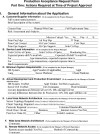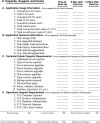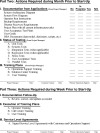- Introduction
- Definition of Production Acceptance
- The Benefits of a Production Acceptance Process
- Implementing a Production Acceptance Process
- Full Deployment of a New Application
- Distinguishing New Applications from New Versions of Existing Applications
- Distinguishing Production Acceptance from Change Management
- Case Study: Assessing the Production Acceptance Process at Seven Diverse Companies
- Summary
- Test Your Understanding
- Suggested Further Readings
Implementing a Production Acceptance Process
The following list details the 14 steps necessary for implementing an effective production acceptance process. Along with our detailed discussion of each of these steps, we will look at actual experiences from industry, where appropriate, to highlight suggestions to pursue and obstacles to avoid.
- Identify an executive sponsor
- Select a process owner
- Solicit executive support
- Assemble a production acceptance team
- Identify and prioritize requirements
- Develop policy statements
- Nominate a pilot system
- Design appropriate forms
- Document the procedures
- Execute the pilot system
- Conduct a lessons-learned session
- Revise policies, procedures, and forms
- Formulate marketing strategy
- Follow up on ongoing enforcement and improvements
Step 1: Identify an Executive Sponsor
Production acceptance is one of a handful of systems management processes that directly involve departments outside of the infrastructure group. In this case it is the applications development area that plays a key role in making this process effective. An executive sponsor is necessary to ensure ongoing support and cooperation between these two departments. Depending on the size and scope of the IT organization, the sponsor could be the CIO, the head of the infrastructure group, or some other executive in the infrastructure. (We should note that an application manager could be an excellent sponsor providing the head of the infrastructure agrees with the selection. In this case, the executives from both departments should concur on the choice of process owner, who needs to be from the infrastructure group.)
In general, the higher the level of executive sponsor, the better. It should be noted that senior executives are usually more time constrained than those at lower levels, so support sessions should be well planned, straightforward, and to the point.
The executive sponsor must be a champion of the process, particularly if the shop has gone many years with no structured turnover procedure in place. He or she needs to be able to persuade other executives both inside and outside of IT to follow the lead. This individual is responsible for providing executive leadership, direction, and support for the process. The executive sponsor is also responsible for selecting the process owner, for addressing conflicts that the process owner cannot resolve, and for providing marketing assistance.
Step 2: Select a Process Owner
One of the first responsibilities of the executive sponsor is to select the production acceptance process owner. The process owner should be a member of the infrastructure organization since most of the ongoing activities of operating and supporting a new production application fall within this group. This person will be interacting frequently with the programmers who developed and will be maintaining the system.
This continual interaction with applications makes a working knowledge of application systems an important prerequisite for the process owner. Being able to evaluate applications documentation and to communicate effectively with program developers are two additional characteristics highly recommended in a process owner. Several other medium-priority and lower-priority characteristics (see Table 9-2) assist in selecting the process lead. These attributes and priorities may vary from shop to shop, but they are intended to emphasize the importance of predetermining the traits that best suit your organization.
Table 9-2. Prioritized Characteristics for a Production Acceptance Process Owner
|
Characteristic |
Priority |
|
Knowledge of applications |
High |
|
Ability to evaluate documentation |
High |
|
Ability to communicate effectively with developers |
High |
|
Knowledge of company's business model |
Medium |
|
Ability to meet effectively with users |
Medium |
|
Ability to communicate effectively with IT executives |
Medium |
|
Ability to promote teamwork and cooperation |
Medium |
|
Ability to manage diversity |
Medium |
|
Knowledge of backup systems |
Medium |
|
Knowledge of database systems |
Medium |
|
Knowledge of desktop hardware and software |
Medium |
|
Knowledge of software configurations |
Medium |
|
Knowledge of systems software and components |
Low |
|
Knowledge of network software and components |
Low |
|
Knowledge of hardware configurations |
Low |
Step 3: Solicit Executive Support
Production acceptance requires much cooperation and support between the applications development and infrastructure departments. Executive support from both of these departments should be solicited to ensure that policies and decisions about the design of the process are backed up and pushed down from higher levels of management.
Step 4: Assemble a Production Acceptance Team
The process owner should assemble a cross-functional team to assist in developing and implementing a production acceptance process. The team should consist of key representatives from the development organization as well as those from operations, technical support, capacity planning, the help desk, and database administration. In cases where the development group is larger than a few hundred programmers, multiple development representatives should participate.
It is important that all key areas within development are represented on this team to ensure support and buy-in for the process. Appropriate development representatives also ensure that potential obstacles to success are identified and resolved to everyone's satisfaction. An effective executive sponsor and the soliciting of executive support (steps 1 and 3) can help to ensure proper representation.
At one company where I managed a large infrastructure group, there were more than 400 programmers in the development department grouped into the four areas of finance, engineering, manufacturing, and logistics. A representative from each of these four areas participated in the development of a production acceptance procedure; each brought unique perspectives, and together they helped to ensure a successful result to the process.
Step 5: Identify and Prioritize Requirements
Early in my career I participated on a number of production acceptance teams that fell short in providing an effective production turnover process. In looking for common causes for these failed attempts, I noticed that in almost every case there were no agreed-upon requirements at the start; when there were requirements, they were never prioritized.
Later on, as I led my own production acceptance design teams, I realized that having requirements that were prioritized and agreed upon by all participants added greatly to the success of the efforts. Requirements vary from company to company, but some are common to almost all instances. Table 9-3 lists some of the more common requirements I have witnessed in successful implementations of production acceptance, along with their typical priorities.
Table 9-3. Sample of Prioritized Requirements
|
Requirement |
Priority |
|
1. Ensure that operations, technical support, help desk, network services, and database administration are all involved early on in implementing a new application. |
High |
|
2. Ensure capacity-gathering requirements are compatible with the capacity planning process. |
High |
|
3. Provide application documentation to operations prior to production turnover. |
High |
|
4. Develop and enforce management policy statements. |
High |
|
5. Ensure adequate service desk support from applications during the first week of production. |
Medium |
|
6. Implement a pilot subset for very large applications. |
Medium |
|
7. Do not set up a separate help desk for a new application. |
Medium |
|
8. Ensure that a user test plan is developed and executed. |
Medium |
|
9. Ensure that a user acceptance plan is developed and executed. |
Medium |
|
10. Analyze daily the types and frequencies of service desk calls during the first two weeks of production; then weekly thereafter. |
Medium |
|
11. Leverage the use of existing tools and processes. |
Medium |
|
12. Simplify forms as much as possible for ease of use. |
Low |
|
13. Involve appropriate groups in the design and approval of forms. |
Low |
|
14. Ensure that developers estimate the type and volume of service desk calls during the first week of production. |
Low |
|
15. Include desktop capacity requirements. |
Low |
|
16. For systems being upgraded, ensure that all impacts to end-users are identified up front. |
Low |
Step 6: Develop Policy Statements
The cross-functional team should develop policy statements for a production acceptance process. These statements should then be approved by the executive sponsor. Policy statements help ensure that issues such as compliance, enforcement, and accountability will be supported by senior management and communicated to the applicable levels of staffs. The following lists some sample policy statements:
- All new mainframe- or server-based applications are to go through the formal production acceptance process prior to deployment into production.
- All major new versions of existing production applications are to go through the formal production acceptance process prior to deployment into production.
- Process owner ([insert name]) is responsible for coordinating and maintaining the production acceptance process and has authority to delay an application's deployment into production pending full compliance with the process.
- Key support groups such as operations, technical support, network services, database administration, and the help desk are to be informed about the application from its start and involved with its development as prescribed by the production acceptance process.
- Development owners of applications that are deployed through the production acceptance process are expected to regularly update the capacity plan for their applications to ensure adequate resource support in the future.
- Any applications deployed through the production acceptance process that require substantial desktop capacity upgrades are to provide specific requirements to capacity planners with sufficient lead time for planning, ordering, delivering, and installing all upgrades.
Step 7: Nominate a Pilot System
When a production acceptance process is designed and implemented, particularly in environments that have never had one, there is normally a major change in the manner in which application systems are deployed. Therefore, it is usually more effective to introduce this new method of production turnover on a smaller scale with a minimal-impact pilot system. If a small system is not available as a pilot, consider putting only an initial portion of a major system through the new process.
Step 8: Design Appropriate Forms
During the requirements step, the cross-functional team normally discusses the quantity, types, and characteristics of forms to be used with a production acceptance process. The following list details some of the forms that are typically considered here. Some shops elect to combine some or all of these forms, depending on their complexity.
- Primary production acceptance form
- Capacity planning form
- Customer-acceptance form
- Service desk form
- Testing plan
- Lessons-learned form
- The capacity form is for periodic updates to resource requirements.
- The customer-acceptance form is for user feedback prior to deployment.
- The service desk form is for anticipated calls during start-up.
- The test plan is for developers to show function and performance of the new system.
- The lessons-learned form is for follow-up and improvements after full deployment of a new system.
The forms are proposed, designed, and finalized by the team. Figure 9-1 shows a production acceptance form used by one of my clients. Specific requirements of the form vary from shop to shop, but the form should always be simple, thorough, understandable, and accessible. Many shops today keep forms like these online via their company intranets for ease of use and access.

Figure 9-1 Sample Production Acceptance Form (page 1 of 3)

Figure 9-1 Sample Production Acceptance Form (page 2 of 3)

Figure 9-1 Sample Production Acceptance Form (page 3 of 3)
Step 9: Document the Procedures
The documentation of any systems management process is important, but it is especially so in the case of production acceptance because such a large number of developers will be using it. The documentation for these procedures must be effective and accessible (see Chapter 20 for ways to ensure that documentation is both of high quality and of high value).
Step 10: Execute the Pilot System
With a pilot system identified, forms designed, and procedures in place, it is time to execute the pilot system. User testing and acceptance plays a major role in this step, as does the involvement of support groups such as technical support, systems administration, and the help desk.
Step 11: Conduct a Lessons-Learned Session
In this step, the process owner conducts a thorough, candid lessons-learned session with key participants involved in executing the pilot system. Participants should include representatives from the user community, development area, support staff, and help desk.
Step 12: Revise Policies, Procedures, and Forms
The recommendations resulting from the lessons-learned session may include revisions to policies, procedures, forms, test plans, and training techniques for users and support staff. These revisions should be agreed to by the entire cross-functional team and implemented prior to full deployment.
Step 13: Formulate Marketing Strategy
Regardless of how thoroughly and effectively a cross-functional team designs a production acceptance process, the process does little good if it is not supported and applied by development groups. Once the final policies, procedures, and forms are in place, the process owner and design team should formulate and implement a marketing strategy. The marketing plan should include the benefits of using the process; the active support of the executive sponsor and peers; examples of any quick wins as evidenced by the pilot system; and testimonials from users, service desk personnel, and support staff.
Step 14: Follow-up for Ongoing Enforcement and Improvements
Improvement processes such as production acceptance often enjoy much initial support and enthusiasm, but that is sometimes short-lived. Changing priorities, conflicting schedules, budget constraints, turnover of staff or management, lack of adequate resources, and a general reluctance to adopt radically new procedures all contribute to the de-emphasis and avoidance of novel processes. One of the best ways to ensure ongoing support and consistent use is to follow up with reviews, postmortems, and lessons learned to constantly improve the overall quality, enforcement, and effectiveness of the process.